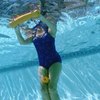This article provides a basic water aerobics routine that can be tailored to suit your individual needs.
Warm up. As with any exercise program, it is beneficial to gently warm up the muscles of the body. Start with a few, gentle laps walking across the pool, in the shallow end if needed.
Using a flotation device will decrease the difficulty level and can be an easy way to warm up without straining yourself. Place the noodles under your arms or between your legs to help hold you up.
Warm-up for about 5 minutes before beginning the more intense portion of the water aerobics. Beginners may feel free to modify the aerobics routine by staying in the shallow end where it is easy to touch.
Mix up your moves. There are several different "moves" or "steps" that can be done during a water aerobics routine. In a typical class setting change the moves every 1 or 2 minutes. The more frequently you change what you are doing, and the direction you are moving in, the higher the difficulty level of the routine.
Do the breast stroke. In the breast stroke, your arms come out from your chest, forward and ahead of you in the water, and then push down and around to begin again. Your legs make a frog kick motion that is great for exercising the inner thighs. Your body will be leaning slightly forward in the water but there is no reason to put your face in the water if you don't want to.
Punch. Position your body in a more upright, sitting posture and think about pushing your hands straight out from your shoulders and into the water. The motion is very similar to a boxer punching a punching bag.
Swing arms. When using a swinging arm motion, you will move your arms as though you were walking very quickly; keeping your elbows straight makes it more difficult.
Paddle. Just as the name implies, when you are dog paddling you would use a short, choppy, scooping strokes with your hands.
Use your legs. The bicycle leg motion describes this move. With this leg stroke, you'll bend at the knees to move your feet in a cycling or paddling motion.
Ski. As with the straight arm motion, this movement is done with straight legs that move in a skiing posture. Think about keep your feet flexed instead of pointed to avoid leg cramps.
Work those legs by using the helicopter leg motion. This movement can be done stationary for the best effect and involves rotating your legs in an egg-beater fashion to keep you afloat in the water. To add to the difficulty level, raise your arms above your head and try to keep your face above the water. Alternatively, use your arms to help or a noodle under your armpits for added support.
Use the last five minutes of your water aerobics routine to cool down and slow down after your difficult workout.
Try using the side of the pool to do some simple stretches. For example, place one foot on the side of the pool and stretch the inner thigh. Or grab the edge of the pool and lean to the side to stretch your arms and shoulders.
Tip
To increase the difficulty of the water aerobics routine: 1) Change directions often--first move forwards for a length or two and then move backwards in the water for a length or two. 2) Move into deeper water or remove flotation devices so you are fully supporting your own weight in the water. Remember to stay fully hydrated. Keep a water bottle at the edge of the pool to sip on as you go through your water aerobics routine. Water aerobics is a great exercise choice for times when low impact is more beneficial including while pregnant or even if you suffer from arthritis, obesity and other medical conditions. Ask your doctor if water aerobics is right for you.
Tip
-
Don't overdo it. If you find yourself unable to carry on a comfortable conversation, you may be pushing yourself too hard. If this is the case, slow down, add a "noodle" or other flotation device or stop and stretch at the side of the pool for a minute or two. As with any exercise program, it may be wise to check with your health care provider before beginning a strict work-out routine.
Image Credit
Herman Brinkman





